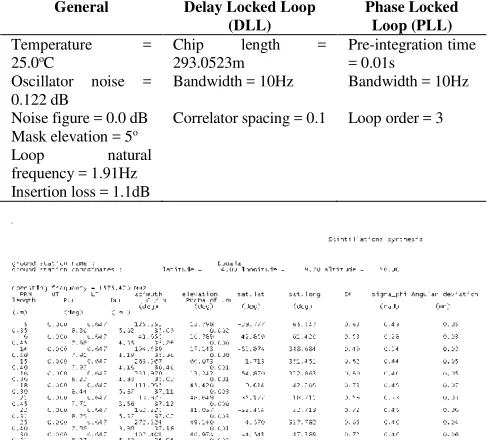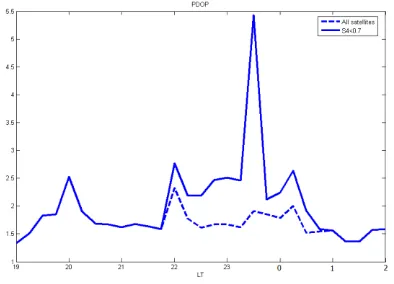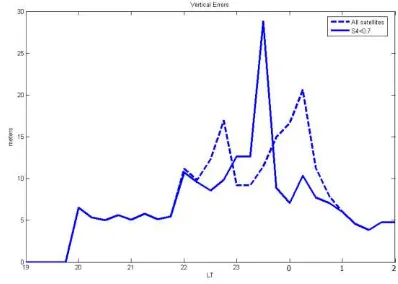69:2 (2014) 33–38 | www.jurnalteknologi.utm.my | eISSN 2180–3722 |
Teknologi
Global Positioning System (GPS) Positioning Errors During Ionospheric
Scintillation Event
Y. H. Hoa*, S. Abdullahb, M. H. Mokhtarb
aFaculty of Electronic and Computer Engineering, Universiti Teknikal Malaysia Melaka (UTeM), Melaka, Malaysia bInstitute of Space Science (ANGKASA), Universiti Kebangsaan Malaysia (UKM), Selangor, Malaysia
*Corresponding author: [email protected]
Article history
Received :1 January 2014 Received in revised form : 15 February 2014 Accepted :18 March 2014
Graphical abstract
Abstract
As technology advancement progresses throughout the years in this modern age, every technology has its part to play in that the world is moving towards a brighter future. GPS (Global Positioning System) has diverse application in current globalized world, its application has pervasive benefits not only to navigation and positioning, it is pivotal in industries like logistics, shipping, financial services and agriculture. Since the decision to shut down the Selectivity Availability (SA) by former U.S. President, Bill Clinton, ionospheric effect is now the primary concern of error contributing factors in GPS. Ionospheric scintillation induces rapid fluctuations in the phase and the amplitude of received Global Navigation Satellite System (GNSS) signals. These rapid fluctuations or scintillation potentially introduce cycle slips, degrade range measurements, and if severe enough lead to loss of lock in phase and code. Global Ionospheric Scintillation Model (GISM) was used to compute amplitude scintillation parameter for each GPS satellite visible from Melaka, Malaysia (Latitude 20 14’ N, Longitude 1020 16’ E) as its location has strong equatorial scintillation behavior. The output data from GISM was then used to calculate the positioning error where it is depends on the Dilution of Precision (DOP) and User Equivalent Range Error (UERE). There are two schemes that were used. First, the positioning error was calculated for all the visible satellites with better DOP but worse UERE due to scintillation event. Secondly, the positioning error was calculated for those satellites that have amplitude scintillation index, S4 < 0.7 which leads to worse DOP with better UERE. Comparison of results from the both schemes was then made.
Keywords: GPS; scintillation; positioning error
© 2014 Penerbit UTM Press. All rights reserved.
1.0 INTRODUCTION
The Global Positioning System (GPS) is being developed and operated to support military navigation and timing needs. For the past few decades, more and more attention is given in its suitability for civil applications. The complete GPS system consists of 24 operational satellites and provides 24 hours, all weather navigation and surveying capability worldwide. A major milestone in the development of GPS was achieved on 8 Dec 1993, when the 24 satellites (Blocks I, II, IIA) were successfully operating.
The satellites transmit at frequencies L1 = 1575.42 MHz and L2 = 1227.6 MHz. Two types of codes and a navigation message are modulated into the GPS signals. The two types of codes are the Coarse/Acquisition (C/A) code and restricted Precision (P) code. The C/A code is a 1,023 bit deterministic sequence called PseudoRandom Noise (PRN) code transmitted at 1.023 Mbit/s and repeats every millisecond. There is strong self-correlation and weak cross-correlation for PRN codes transmitted by GPS which enable the receiver to recognize multiple satellites on the same
frequency. The P code is also a PRN; however, the P code was encrypted with Y code to become P(Y) code and only can be accessed by authorized receiver.
Selective Availability (SA) was an intentional degradation of the GPS signal by the U.S. government. Due to this, the level of accuracy was limited to 100 m horizontal position (95% probability) and 140 m vertical position (95% probability). This condition was imposed in order to restrict the full accuracy of the GPS system to authorized military users only. After the SA was officially turned off at midnight on May 1, 2000, the ionosphere became the greatest source of error in GPS applications.
The ionosphere is part of the upper atmosphere and extends over the region between approximately 50 and 1500 km above the
Earth’s surface where free electrons and positive charged particles
signal path. However, the properties of the ionosphere are well-known with its structure and electron density varies strongly with time, geography location, solar activities and geomagnetic activity. The dynamics of the ionosphere is remarkable whereas one or two orders changes in magnitude of the electron content are not a rare event.
Ionospheric scintillations are rapid variations in the amplitude and phase of transionospheric radio signals resulting from density irregularities in the ionosphere. Scintillations show strong diurnal, seasonal, geographic and solar cycle dependence being at their most severe during the evening hours, in the months of the equinox, at equatorial latitudes and during the years of solar maximum. As the next solar maximum is predicted to occur in May 2013, it is expected that scintillation activity will increase over the coming years.
Scintillations affect GPS receivers at the tracking loop level and so have the potential to disrupt all GPS systems, including both single and dual frequency receivers and both stand-alone and differential systems. The errors introduced into the code and carrier tracking loops of a GPS receiver result in an increase in range measurement errors and under extreme conditions can lead to a complete loss of signal lock. Other effects include an increase in the probability of errors within the GPS navigation data and an increase in the time taken to acquire the GPS signal when a receiver is first turned on. However, as scintillations are unlikely
to affect all of the satellites in a receiver’s field of view
simultaneously, their impact on navigational accuracy will be through degradation in the geometry of the available constellation. Consequently, the coverage of both the satellites and the irregularities, as well as the intensity of scintillation activity will all contribute to the accuracy of the final position solution. Ho & David proposed a stochastic model considering individual satellite signal quality on GPS positioning [1]. However, the model is far more complicated by using the tracking jitter errors as weight for their stochastic model.
2.0 POSITIONING ERRORS MODELING USING
GLOBAL IONOSPHERIC SCINTILLATION MODEL (GISM)
GISM is a model that was developed at IEEA, Courbevoie, France by Yannick Beniguel. It uses the Multiple Phase Screen technique (MPS) which consists of an application of the Parabolic Equation (PE) for a medium divided into successive layers. Each of the layers acts as a phase screen [2]. The GISM program is a mixed climatological and physical model which includes a model of irregularities and their variation with geomagnetic latitude, longitude, time of day, season of year and sunspot number. Mean errors are obtained employing a ray technique using the values of the ionosphere electron density obtained with NeQuick model [3] which is included in GISM. The normalized standard deviations of intensity (S4) and phase () at ground level are calculated in the first stage. After specification of the receiver characteristics, the signal scintillations at receiver level are then calculated. Further details of the GISM program can be found in [4].
GISM was used to compute amplitude and phase scintillation parameters for each GPS satellite visible from
Melaka, Malaysia (Latitude 20 14’ N, Longitude 1020 16’ E) as
its location has strong equatorial scintillation behaviour in that region. The errors were derived from these parameters and from typical receiver characteristic. Some parameters for typical receiver characteristics are shown in Table 1. Figure 1 shows the results obtained from GISM.
The output data from GISM was then used to calculate the positioning error. There were two schemes that were used. First,
the positioning error was calculated for all the visible satellites. Secondly, the positioning error was calculated for those satellites that have S4 < 0.7. Comparison of results from both schemes was then made.
Table 1 Typical the receiver characteristics of GISM
General Delay Locked Loop
Bandwidth = 10Hz Bandwidth = 10Hz
Noise figure = 0.0 dB Correlator spacing = 0.1 Loop order = 3 Mask elevation = 5o
Loop natural frequency = 1.91Hz Insertion loss = 1.1dB
Figure 1 Scintillations synthesis from GISM
2.1 Positioning Errors
In most cases, scintillation doesn’t affect all visible satellites. If
the number of satellites is four or more than a standard receiver should be able to provide positioning information. However, the number of satellites and their positions affect the positioning precision. The Dilution of Precision (DOP) is usually used to
Scintillations in GPS reduce the effectiveness of determining the position. They will affect the signals received from the GPS satellite. However, not all are necessarily affected by it. It depends
on the satellite’s locations and the location and properties of the irregularities. Usually each receiver is able to detect between 9 to 11 GPS satellites at a time. A minimum of four satellites are required to enable each receiver to determine a position. As long as scintillation does not affect a minimum of four satellites, the receiver may still be able to provide the receiver position, though the position will be less accurate.
compared with the situation where satellites that are close to each other which has a poor geometry. Poor geometry is when the satellites are in the same plane, orbiting close to each other, or at similar elevations.
DOP can be calculated in a number of ways. There are 5 measures of DOP; Geometrical Dilution of Precision (GDOP), Position Dilution of Precision (PDOP), Horizontal Dilution of Precision (HDOP), Vertical Dilution of Precision (VDOP) and Time Dilution of Precision (TDOP). PDOP consists of HDOP and VDOP. GDOP consists of PDOP and TDOP.
2.2 DOPs Calculation
In order to calculate the DOP values, the satellites and receiver position in World Geodetic Survey 1984 (WGS84) Earth-Centered Earth-Fixed (ECEF) coordinate is required. From the GISM program, each of the satellites position in latitude, longitude and altitude is given for every epoch. This position was converted to ECEF coordinate using the equations below.
= [√ −��2sin2�+ ℎ] cos � cos �
ais equatorial Earth’s radius (6378137 m) e is first eccentricity (0.081819190842622 m) h is height above WGS84 ellipsoid (20200000 m) is geodetic latitude (radians)
is geodetic longitude (radians)
Then, pseudoranges (Ri) from receiver position to each of the satellites are calculated using equation
�= √( �− ) + ( �− ) + ( �− ) (3)
t is signal travelling time from ith satellite to receiver (s)
From the directional derivatives, covariance matrix (A) for each of the satellites was produced as below.
� = [ ⋮⋮
Then, DOP was calculated using this equation.
= √ , + , + , + ,
= √ , + , + ,
= √ , + ,
= √ ,
= √ ,
2.3 User Equivalent Range Error (UERE)
User Equivalent Range Error (UERE) represents the combined effect of space and control segment errors (satellite vehicle position and clock errors), atmospherics (ionospheric and tropospheric), and user equipment errors (receiver measurement uncertainties).
Space and control segment errors are indicated in the form of User Range Accuracy (URA). Each of the GPS satellite transmits the URA value consists all errors such as satellite clock error and Selective Availability (SA). All of these errors will be corrected by the control segment on earth and will be uploading to each of the satellites. The URA index broadcast by each satellites will change over time and its value depends on the length of time since the last control segment upload to that satellite.
Atmospheric errors are errors that are caused by the ionosphere and troposphere affecting the satellite RF signal. Ionospheric effects include the delay and loss of signal and this depends on the
time of day, season of the year, sunspot activity and satellite’s
elevation angle. The tropospheric effect is quite small in comparison.
User Equipment Errors (UEE) are errors that are caused by the uncertainties in the measurements. These uncertainties include the design of tracking loops, the code type being tracked (C/A or P(Y)), and the strength of satellite signals, receiver noise, multipath, and antenna orientation.
UERE cannot be broadcast by the satellites and can only be estimated at the receiver. The fact that sets UERE apart from other measures of error is that the UERE does not take into account any satellite geometry effects, such as HDOP or VDOP. UERE are calculated using the mean of range error that was produced from GISM program.
=∑ �
Where,
Ri is range error j is number of satellites
3.0 RESULTS AND DISCUSSION
3.1 Results Obtained for DOPs
The GISM program was used to compute all the scintillation parameters for each GPS satellite visible from Melaka, Malaysia (Latitude 2014’ N, Longitude 102016’ E). The tracking error was
derived from these parameters and from typical receiver characteristics. DOP values were evaluated with a 5o antenna
mask (signals 5o or more above the horizon).
Figure 2 GDOP at Melaka under scintillation conditions computed with GISM
Figure 3 PDOP at Melaka under scintillation conditions computed with GISM
Figure 4 HDOP at Melaka under scintillation conditions computed with GISM
Figure 5 VDOP at Melaka under scintillation conditions computed with GISM
As mentioned before, in general, the more satellites there are, the better (lower) the DOPs value will be. Figure 2 – 5 above presents the comparison of DOPs (GDOP, PDOP, HDOP and VDOP) that was evaluated in two cases; for all satellites and also for just those with S4 < 0.7. Satellites with S4 above 0.7 were considered facing strong amplitude scintillation and were ignored for the DOP evaluation. DOPs values for all satellites are better compared with the value of the several satellites that was taken with the S4 below the 0.7 threshold. The above threshold value was chosen based on the widely agreement for definition of strong amplitude scintillation with S4 > 0.7. S4 above the 0.7 threshold occurs during the post sunset time from about 10.00 pm to 1.00 am local time in equatorial region.
3.2 Results for Positioning Errors
For the positioning error, the DOP values that were calculated were multiplied by the UERE as Equation 1. The UERE was calculated from the mean of the range error that was produced from GISM as Equation 5.
Figure 6 UERE at Melaka under scintillation conditions computed with GISM
Figure 6 shows resulting UERE on both schemes. As expected, high values of UERE were obtained from all satellites considered. It is because of the additional error due to strong scintillation. Lower values of UERE were obtained from satellites with S4 < 0.7 to reduce the errors due to scintillation.
Figure 7 Geometrical errors at Melaka under scintillation conditions computed with GISM
Figure 8 Positional Errors at Melaka under scintillation conditions computed with GISM
Figure 9 Horizontal errors at Melaka under scintillation conditions computed with GISM
Figure 10 Vertical errors at Melaka under scintillation conditions computed with GISM
Figure 6–10 show positioning errors as from Equation 1 for GDOP, PDOP, HDOP and VDOP respectively at Melaka under scintillation conditions computed with GISM. Dashed lines show positioning errors obtained with all satellites consideration, and solid lines show positioning errors obtained from satellites with S4 < 0.7.
Results show positioning errors due to scintillation effects cannot be simply improved by excluding satellites with high scintillation parameter in positioning computation. UERE can always been improved by excluding satellites with high scintillation parameter, however, DOP will always increase. From the simulation results, the positioning errors improved during 2200 – 2300 LT and 0000 – 0100 LT. However, during 2300 – 2400 LT, the decreased values of UERE could not counter increased values of DOP and lead to an increase of positioning errors.
4.0 CONCLUSION
In this paper, the GISM was used to simulate all scintillation parameters for each GPS satellite visible from Melaka, Malaysia
(Latitude 20 14’ N, Longitude 1020 16’ E). The output data from
To conclude, positioning errors cannot simply be improved by excluding those GPS paths affected by strong scintillation. The position of all visible satellites plays a vital role in positioning accuracy. The plan of excluding GPS satellite paths with S4 > 0.7 is not sufficient to counter positioning errors due to increased values of DOPs.
Acknowledgement
The authors would like to acknowledge the support of this work by Ministry of Higher Education Malaysia and Universiti Teknikal Malaysia Melaka (UTeM) on research grant
FRGS/2012/FKEKK/SG02/02/1/F00125 and FRGS
(RACE)/2012/FKEKK/SG02?02/01/F00150.
References
[1] Ho, Y. H. and David, F. W. Yap. 2011. Stochastic Model Considering
Individual Satellite Signal Quality on GPS Positioning. IEEE International Conference on Computer Applications and Industrial
Electronics (ICCAIE) , Penang, Malaysia, 4–7 Dec. 2011.
[2] Beniguel, Y., Forte, B., Radicella, S., Strangeways, H., Gherm, V., &
Zernov, N. 2004. Scintillation Effects on Satellite to Earth Links
Telecommunication and Navigation Purposes. Annals of Geophysics. 47:
2/3.
[3] Di, Giovanni, G. and S. M. Radicella. 1990. An Analytical Model of the
Electron Density Profile in the Ionosphere. Adv. Space Res. 10(11): 27–
30.
[4] Beniguel, Y. 2004. Global Ionospheric Scintillation Model. Technical


